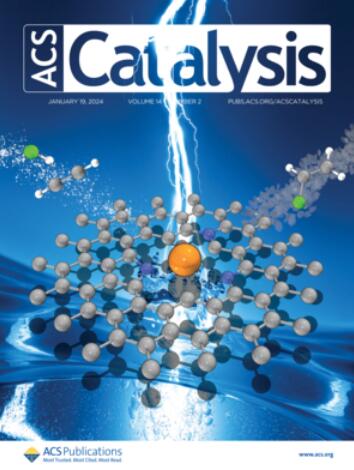Cu-Catalyzed Chemoselective Borylcupration of Borylated (Z)-Skipped Dienoates: A Case Study for the Synthesis of gem-diborylcyclobutanes
IF 11.3
1区 化学
Q1 CHEMISTRY, PHYSICAL
引用次数: 0
Abstract
Chemoselective borylcupration of borylated (Z)-skipped dienoates is controlled by the ester group to access 3,3-di(pinacol)borylalkenoates. Electrophilic trapping with H+, D+, alkyl-, benzyl-, or allyl halides, as well as isocyanates has proved to be efficient for α-functionalized products. The Cu-catalyzed borylcupration of skipped dienoates containing C–Br bonds resulted in concomitant ring closing sequences toward alkylidene gem-diborylcyclobutane scaffolds. We performed DFT calculations to characterize the reaction mechanism of the formation of gem-diborylcyclobutanes. The key steps of the proposal comprise a selective borylcupration directed by alkene substituents, followed by an intramolecular C–C coupling toward strained four-membered rings assisted by the potassium cation. We also analyzed the effect of the nature of the halogen leaving group on the selectivity. The versatility of alkylidene cyclobutanes has been demonstrated through postfunctionalization reactions.铜催化硼化(Z)跳过二烯酸酯的化学选择性硼铜化:宝石-二硼基环丁烷合成的案例研究
硼化(Z)跳过二烯酸酯的化学选择性硼铜化是由酯基控制的,以获得3,3-二(品萘酚)硼烯酸酯。与H+, D+,烷基,苄基或烯丙基卤化物以及异氰酸酯的亲电捕获已被证明对α-功能化产物是有效的。铜催化的含C-Br键的跳过的己烯酸酯的硼铜化反应产生了与烷基基-二硼基环丁烷支架相关的闭合环序列。我们用DFT计算表征了宝石-二硼基环丁烷的生成反应机理。该建议的关键步骤包括由烯烃取代基引导的选择性硼铜化,然后是由钾阳离子辅助的分子内C-C偶联到应变的四元环。并分析了卤素离去基性质对反应选择性的影响。烷基基环丁烷的多功能性已通过后官能化反应得到证实。
本文章由计算机程序翻译,如有差异,请以英文原文为准。
求助全文
约1分钟内获得全文
求助全文
来源期刊

ACS Catalysis
CHEMISTRY, PHYSICAL-
CiteScore
20.80
自引率
6.20%
发文量
1253
审稿时长
1.5 months
期刊介绍:
ACS Catalysis is an esteemed journal that publishes original research in the fields of heterogeneous catalysis, molecular catalysis, and biocatalysis. It offers broad coverage across diverse areas such as life sciences, organometallics and synthesis, photochemistry and electrochemistry, drug discovery and synthesis, materials science, environmental protection, polymer discovery and synthesis, and energy and fuels.
The scope of the journal is to showcase innovative work in various aspects of catalysis. This includes new reactions and novel synthetic approaches utilizing known catalysts, the discovery or modification of new catalysts, elucidation of catalytic mechanisms through cutting-edge investigations, practical enhancements of existing processes, as well as conceptual advances in the field. Contributions to ACS Catalysis can encompass both experimental and theoretical research focused on catalytic molecules, macromolecules, and materials that exhibit catalytic turnover.
 求助内容:
求助内容: 应助结果提醒方式:
应助结果提醒方式:


